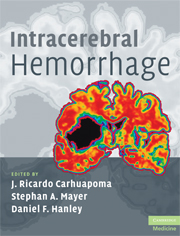Book contents
- Intracerebral Hemorrhage
- Intracerebral Hemorrhage
- Copyright page
- Dedication
- Contents
- Contributors
- Foreword
- Section 1 Epidemiology
- Section 2 Etiology of non-traumatic intracerebral hemorrhage
- Chapter 3 Etiology of tumor-related intracranial hemorrhage
- Chapter 4 Cerebral amyloid angiopathy
- Chapter 5 Coagulopathy-related intracerebral hemorrhage
- Chapter 6 Vascular malformations of the brain
- Chapter 7 Cerebral venous thrombosis and intracerebral hemorrhage
- Section 3 Clinical presentation
- Section 4 Diagnostic investigations
- Chapter 10 MRI of intracerebral hemorrhage
- Chapter 11 Cerebral angiography
- Chapter 12 Laboratory and other ancillary testing in intracerebral hemorrhage: an algorithmic approach
- Section 5 Management and critical care
- Chapter 14 Surgical management of intracerebral hemorrhage
- Chapter 15 Future therapy in intracerebral hemorrhage and intraventricular hemorrhage: aspiration and thrombolysis
- Section 6 Prognosis and outcome
- Section 7 Advances in pathogenesis and treatment of intracerebral hemorrhage: experimental
- Chapter 18 Thrombin and secondary brain damage following intracerebral hemorrhage
- Chapter 19 Cytoprotection strategies for experimental intracerebral hemorrhage
- Section 8 Advances in pathogenesis and treatment of intracerebral hemorrhage: clinical
- Chapter 21 Hemostatic therapy for intracerebral hemorrhage
- Index
Chapter 12 - Laboratory and other ancillary testing in intracerebral hemorrhage: an algorithmic approach
Published online by Cambridge University Press: 04 May 2010
- Intracerebral Hemorrhage
- Intracerebral Hemorrhage
- Copyright page
- Dedication
- Contents
- Contributors
- Foreword
- Section 1 Epidemiology
- Section 2 Etiology of non-traumatic intracerebral hemorrhage
- Chapter 3 Etiology of tumor-related intracranial hemorrhage
- Chapter 4 Cerebral amyloid angiopathy
- Chapter 5 Coagulopathy-related intracerebral hemorrhage
- Chapter 6 Vascular malformations of the brain
- Chapter 7 Cerebral venous thrombosis and intracerebral hemorrhage
- Section 3 Clinical presentation
- Section 4 Diagnostic investigations
- Chapter 10 MRI of intracerebral hemorrhage
- Chapter 11 Cerebral angiography
- Chapter 12 Laboratory and other ancillary testing in intracerebral hemorrhage: an algorithmic approach
- Section 5 Management and critical care
- Chapter 14 Surgical management of intracerebral hemorrhage
- Chapter 15 Future therapy in intracerebral hemorrhage and intraventricular hemorrhage: aspiration and thrombolysis
- Section 6 Prognosis and outcome
- Section 7 Advances in pathogenesis and treatment of intracerebral hemorrhage: experimental
- Chapter 18 Thrombin and secondary brain damage following intracerebral hemorrhage
- Chapter 19 Cytoprotection strategies for experimental intracerebral hemorrhage
- Section 8 Advances in pathogenesis and treatment of intracerebral hemorrhage: clinical
- Chapter 21 Hemostatic therapy for intracerebral hemorrhage
- Index
Summary
Keywords
- Type
- Chapter
- Information
- Intracerebral Hemorrhage , pp. 149 - 158Publisher: Cambridge University PressPrint publication year: 2009

